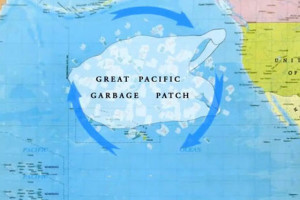Everyone knows that rubbish ends up in the ocean, but did you know that there is a patch of garbage twice the size of Texas floating between Hawaii and California?
Yup, that’s right. A large collection of mostly plastic items like discarded fishing nets , plastic bottles and polystyrene cups is currently swirling it’s way around the North Pacific ocean. It’s called the Great Pacific Garbage Patch (GPGP). It’s not alone though, in fact there are a number of these gyres in oceans around the world. This one just happens to be the largest. There’s one in the North Atlantic, another in the Indian Ocean in between Australia and Antarctica. Oh, and there’s two more in the South Atlantic and South Pacific.
So, What Is a Gyre?
Basically, thanks to ocean currents and the Earth’s rotation there are vortexes in all our oceans that pull together. The problem is that now there is so much plastic in the ocean, the garbage is being pulled along and forming these garbage patches.
Fast Facts:
– In parts of the GPGP there are over 2 million pieces of plastic per square mile of ocean.
– Marine life like turtles and fish mistake tiny pieces of plastic for sea plankton and ingest items their bodies cannot break down
– By 2050 it’s estimated that there will be more plastic in the ocean than fish
– 80% of the garbage found in the ocean is from land based sources, leaving the other 20% coming from commercial cruises, fishing and shipping
– Ocean pollution kills an estimated one million seabirds each year
Why Are the Garbage Patches There?
The GPGP was first documented in 1988 but scientists believe over the last decade or so the patch has rapidly accelerated in size. The solution seems quite simple: locate the garbage patch and remove it. But it’s actually a lot more complicated than that. It’s difficult to locate from air and it’s even harder to get close enough to it to actually remove it. It’s not a massive island of floating garbage but more of a cloudy ocean soup of micro-plastics. However, the biggest thing standing in the garbage patch’s removal is the fact that no country wants to take responsibility for it. Although it lies off the coast of The United States, a lot of the rubbish is believed to have originated from East Asia. This is mainly because thanks to the ocean highway, a piece of plastic discarded into the ocean in Japan will take roughly 1 year to reach the patch whereas the same plastic would take 6 years from California.
Can Anything Be Done?
While people were up in arms when Coles and Woolworths stopped handing out single use plastic bags, it’s actually a great step in the right direction. Cutting down on single use plastics in every aspect of your life can reduce the amount that eventually ends up in our oceans. Easy things to cut out are coffee cups, straws and excess plastic when grocery shopping. Do you really need that extra plastic bag for your spuds? Or how about using eco-friendly skin and beauty products? Micro-beads that go into face and body washes end up washing down your drain and into the stomachs of turtles. If you are really keen to help save our oceans then volunteer for a ocean clean up day, or next time you’re at the beach or river why not pick up a couple pieces of rubbish while you’re there?
What do you think LiveTribers? Is it time to ditch the plastic for good to save our oceans?











